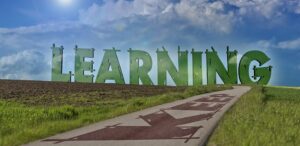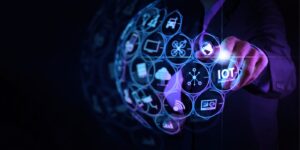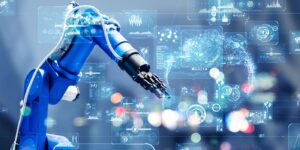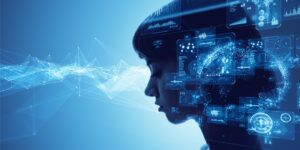
AI & Automation: The Augmentation of Labor
Pam Sornson, JD
June 6, 2023
Not only did advanced technology preserve millions of jobs during the recent pandemic, but it also transformed millions more. The almost instantaneous leap to a remote and distributed workforce drove an expansion of technological innovation that continues to burgeon today.
The software engineering sector has been steadily introducing new ways to ‘work’ that augment both traditional and emerging labor forms. Two digital tools currently on the rise across the global industrial zone are automation and artificial intelligence (AI), and experts are now re-examining how each will change the nature – and value – of labor.

Digital Drives Change
While it is difficult to achieve a consensus among technology professionals about interim and final outcomes emerging from technological growth, they will almost all agree that everything in the work world will change to some degree. As a result, workers will need new and different training and skills to do their jobs, and many of the jobs themselves will require retooling to accommodate digital progressions.

Automation
The adoption of automated systems to perform previously human labor functions has been flourishing in recent years for many reasons:
Typically, automated ‘robotic’ machines take over mundane and routine tasks, including data entry and processing so that human input can address more sophisticated issues. The work is completed faster and more efficiently than a human can perform it, and in many cases, the machine is also more consistently accurate in performing the function than humans can be when doing the same job.
Additionally, sensors embedded in those machines scan for system elements or aspects that may require maintenance or replacement. These devices are infinitely more sensitive to errant circuitry and processes than humans are capable of achieving, so their function surpasses any labor a person might provide for the same task.
Not insignificantly, machines are also impervious to many situational concerns that inhibit or preclude human activity. Automated devices aren’t affected by the adverse conditions that preclude human engagement, such as excessively hot or cold situations, locations with ultra-high or low-pressure (such as the ocean floor or outer space), and other physically challenging environments.
For these reasons and more, the automation of labor will continue to grow as the cultural norm for the evolution of industry for decades to come.
Consequently, the inputs and activities of the human labor force engaging with those machines will also change:
Workflows will change as workers adapt their new technology ‘colleagues’ to achieve greater productivity. In some cases, systems will speed up as the digitized processing transforms details into insights.
In other cases, the human effort may become obsolete altogether for some elements of a particular task, leaving the workers to assume more managerial/oversight-type functions.
In still other cases, whole systems may be ditched in favor of those that optimize both human and machine labor, augmenting the intrinsic value of each as elements of the success of the whole.
Automation is already deeply embedded into today’s society, being found in almost every vehicle, home, and business. It will continue to permeate virtually all industries as its values and capacities broaden.

AI
AI offers different values and opportunities than automation, but its promise as an economic growth driver is comparable. Some experts define AI as a ‘subset’ of automation that uses automated processes to achieve unique ‘cognitive’ results that are intended – and often presented – as a replacement for human thought. In many cases, the final computation does, indeed, resemble a conclusion that can be or is drawn by a thinking person.
However, at least for now, the operative word in the title of the emerging tool is ‘artificial.’ These machines don’t actually ‘think’ as a human thinks. Instead, they perform a series of ‘machine learning’ programs that run a variety of algorithms to predict a specific outcome. The number and complexity of possible outcomes are dependent on the variables included in the programming, and the machine can only work with the information presented to it. Consequently, the ultimate conclusion drawn by the AI device is only as reliable – and intelligent – as the human that designed and programmed its database.
In a workforce context, AI is bearing a significant influence on the labor ecosystem across four categories of work-related elements:
The design of ‘work’ – The aforementioned ‘predictive’ capacity facilitates the testing of many processes to determine which will be optimal for a particular purpose.
The conduct of work – Built-in analytics enable a review of the efficiencies and deficiencies embedded in workflows, which can drive alterations to how people ‘conduct’ their work.
The measurement of work – Those same analytics provide the opportunity for a deeper comprehension of ever more granular corporate details, which can reveal where and how company assets are maximized – or minimized.
The supply of workers capable of maximizing the value of the technology – Finding workers capable of managing AI technology in any industrial sector is exceedingly difficult these days. There are currently very few technicians within today’s workforce with the skills to master both the complexity of the AI computing process and the swift pace of its innovations. The imbalance between the number of AI technologies and the shortage of skilled AI workers is driving up the value of these workers for every enterprise.
AI is already a significant factor in much of today’s industrial activities, and those existing evolutions multiply the opportunities to adopt yet more AI assets as corporate growth goals.
Both automation and AI are becoming fixtures throughout all facets of society. America’s higher education system has taken note of these emerging opportunities, especially within the community college layer. These leaders are now investing in ways their schools cancan develop more comprehensive technology courses that align with emerging industrial technology demands. As a process, the advancing digital infrastructure is informing all aspects of the workforce development sector, virtually guaranteeing America’s capacity to meet the rising demand and be prepared for the evolutions that will surely follow.


